by Tom Gaylord
Writing as B.B. Pelletier
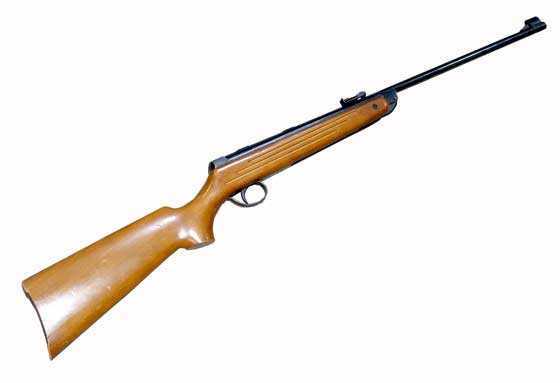
BSA Meteor Mark I.
This report covers:
- Scope base
- Breech lockup
- Spend the money!
- Velocity
- Hobbys
- RWS Superpoint
- JSB Exact RS
- Conclusions
I learned a lot from the comments to Part 1 of this report. Apparently a lot of readers are fascinated by the BSA scope that came as an option. I was asked several questions about how it mounts to the rifle, so let’s start today by looking at that.
Scope base
BSA cut two large dovetails into the spring tube. Then they pressed two steel inserts into these dovetails to create two hard mounting points for the scope ‘rings.’ I put quotes about the word rings because they aren’t rings at all. They are built right into the plastic scope body and as such they cannot be moved. Neither can the scope base oj the rifle be moved. So BSA gives you three holes to adjust the scope’s eye relief.
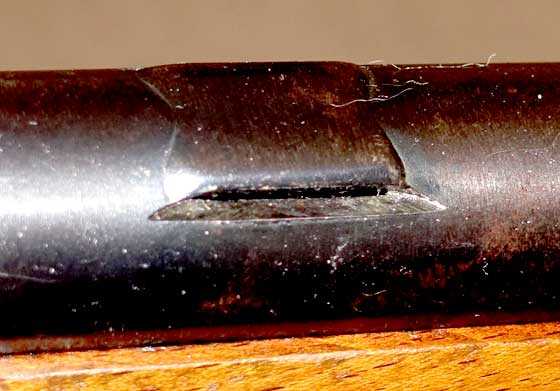
Two wide dovetails have been cut into the top of the spring tube, and hard steel inserts have been pressed into each cut. This forms a hard and immobile place for the scope mount to clamp to.
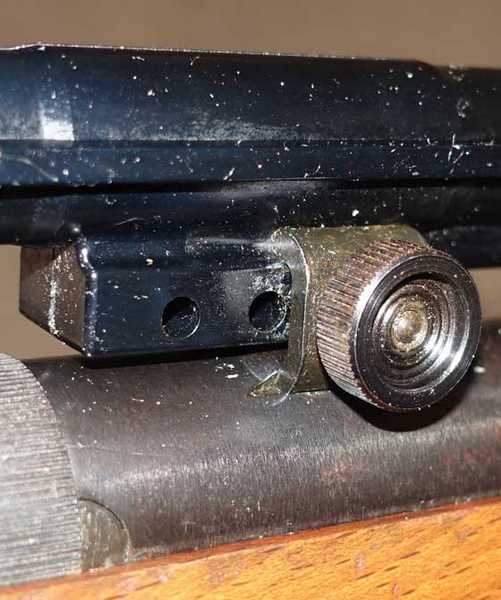
The scope doesn’t have rings. The mount is molded into the plastic body. Three holes allow some movement fore and aft for best eye relief. Pardon all the dust. I brushed the mount before taking the picture, but the plastic attracts and retains dirt.
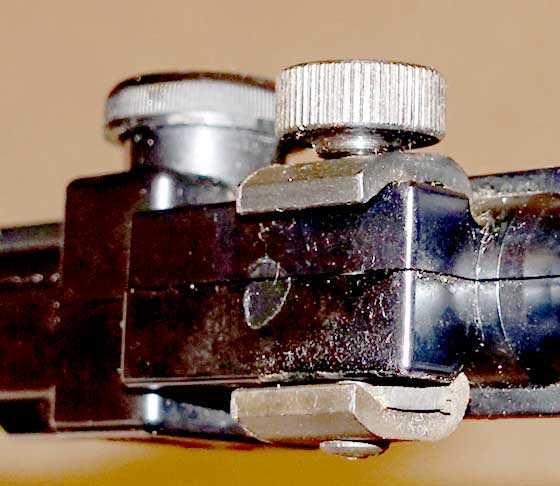
Although the scope body is plastic, the clamp has steel inserts where it matters. These clamp onto the plates in the dovetails on top of the spring tube.
Breech lockup
The other point that reader GunFun1 asked was about the breech lockup. Though the Meteor barrel opens without a slap on the muzzle, the breech locks up tight like a bank vault. This is something modern airgun designers need to study, to learn how BSA does it. I’m showing you what the breech looks like, but the secret is in the strength of the detent spring. They didn’t overdo it.
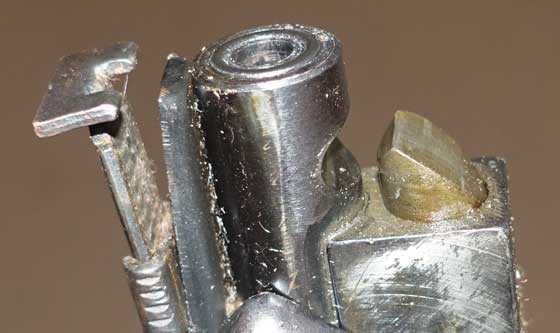
Nothing special about the breech detent, other than the spring isn’t too strong.
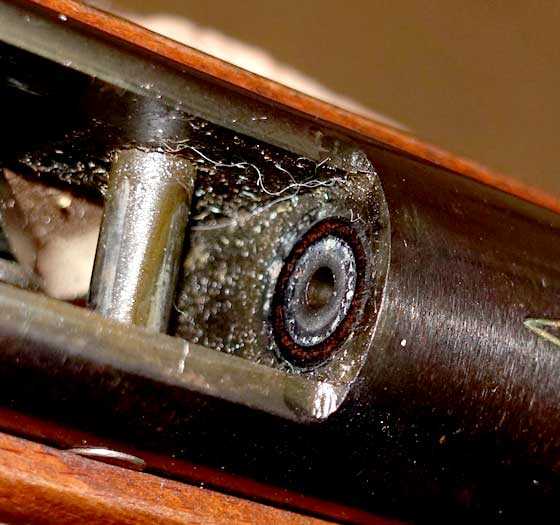
This is where the breech goes when the barrel closes. The shiny steel pin holds the detent (and the barrel) in place.
Spend the money!
One final remark — and this is for an airgun engineer who is currently developing s new breakbarrel. This Meteor has a pivot pin, rather than a bolt that can be tightened. As a result, the breech gets loose with use. This is a common fault of the Meteor. You fix it by crushing the action forks in a vise and hammering the vise to brinnel the forks togethyer tighter. Don’t try this at home unless you are a carrfull worker!
My point is that pivot pins DO NOT WORK on breakbarrels! They always loosen up and accuracy goes out the window. I’m stressing this for the sake of the engineer who has to sell it to a budget oversight review board. Sure, putting a bolt there means greater expense (the bolt costs more, plus the action forks have to be machined to receive it), but SPEND THE MONEY! This is a fatal flaw in some breakbarrels, and yes, I am thinking of some popular models that almost made it but fell short. Their designers haven’t got a clue why that is, but I just told you.
Velocity
Okay, enough talk. Today is velocity day. Let’s see what this baby can do!
Hobbys
This rifle is a .22, so RWS Hobbys weigh 11.9 grains. I expected something in the low 500s and was pleasantly surprised by an average of 615 f.p.s. Reader Dom said to expect 8 foot-pounds, but at this average Hobbys produce 10 foot-pounds on the nose. This rifle is doing very well.
The low was 600 and the high was 624 f.p.s., so a spread of 24 f.p.s. The rifle shoots with a lot of buzz, which I think I will address down the road.
RWS Superpoint
Dom also said RWS Superpoints are a good accurate pellet for a Meteor, so I tested them next. They averaged 547 f.p.s. in my Meteor with a low of 532 and a high of 559 f.p.s. At the average velocity Superpoints averaged 9.57 foot-pounds at the muzzle. The spread was 27 f.p.s.
JSB Exact RS
The last pellet I chronographed was the JSB Exact RS dome. They averaged 565 f.p.s. with a low of 558 and a high of 572. So a total sprtead of 14 f.p.s. At the average velocity RS pellets produced 9.52 foot-pounds at the muzzle.
Conclusions
I have a Mark I Meteor in very good firing condition. I don’t care for the buzzing, but the power is where it should be. To my great surprise, it’s more powerful than the Diana model 27 I’m always touting.
The rifle cocks easily, shoots well and has a tight breech lockup. This one may become a permanent part of my collection. It hinges on the accuracy.

BB,
This sounds like a nifty little plinker. As you said the pivot pin is a kill joy though. That has kept me from buying some otherwise superb break barrels, some of which cost enough money that they should have a bolt. My Webley/Hatsan Tomahawk does, and it has a locking screw also. It cannot cost that much more.
I like that lock up mechanism. That shows some engineering and though it can be cost effective, if a mistake is made you would lose the barrel while if the lock up was only in the barrel block you could remove the barrel and only have to scrap the block. I suppose this mechanism changes in later models.
RR,
I don’t know what you are trying to say. This breakbarrel locks like most breakbarrels. It has no separate lock, like 95 percent of them.
\What are you saying?
B.B.
BB,
Most lock up mechanisms do not directly involve the barrel itself as in this case. If there are issues, the barrel can be removed from the block and the block scrapped and replaced. I am speaking from a manufacturing point of view.
RR,
Oh, now I see what you are saying. The fact that the barrel and not the base block is part of the lockup.
B.B.
BB,
I forgot to mention in my blurb above. You may want to give consideration to that lubricant in a syringe for this air rifle that I have been recommending. I have used it twice now and I am very happy with the results so far. These two air rifles were very “crunchy” and “sproingy” and it smoothed them out very nicely.
RidgeRunner,
You do realize that the majority of this blog’s commentariat prefer the airguns to be stripped down to the basics.
That “Tune In A Tube” sounds like a product that should be reviewed though. Initially used on a springer that is “crunchy” and “sproingy” then a long term follow-up to see how long the tune lasts before re-application is needed. This deprives us of a view of the strip down to see what was actually the problem with the springer.
It does look like a product to be used by those without much time, skill or tools to perform a tune.
Siraniko
Siraniko,
That might be a good idea. These grease jobs do work. I have used them for decades. But they rob power. I might like to look at that closer for everyone.
B.B.
RR,
No, I don’t want to inject grease into the powerplant. I want to get inside and see what is happening. Then perhaps I can retain the power while damping the vibration.
I used to use grease, alone, but that isn’t asd precise a way to tune a rifle.
B.B.
BB,
No, it is not a precision tune and it is certainly not a fix all, but if properly applied it can work wonders. Most tunes require the use of some lubricant and it is usually a very vicious type which will “rob” some power while reducing vibration.
I think that you will agree that unless you know what you are doing, you should not go inside a sproinger powerplant. I at this moment do not have a spring compressor, so I was not about to open up my Webley Tomahawk or my Diana 46. I was able to lubricate the springs without having to do such. Soon I will have a spring compressor and then both will likely receive a proper tune.
The idea of the syringe is to carefully apply the grease where it is needed, not just “inject grease into the powerplant”. Yes, there will be those who will do just that and they will indeed lose power, but unless I am mistaken it would be better to have an over greased powerplant than an under greased one. That is what happened to my 1906 BSA.
RR,
You are right about an over-greased powerplant being best. I will give up 30–40 f.p.s. for smooth shooting.
But when I did the Diana 45 tune, I found that I could remove the base reasons for vibration and still get a power boost if I was careful. That’s what I’m talking about.
Still, the Meteor as it now sits might just be the perfect testbed for a grease tune followed by a precision tune.
B.B.
BB,
Most especially if you follow each with chronograph results to help illustrate the effectiveness of each.
RR,
That plus an assessment of how smooth it shoots would be the only evaluation criteria.
B.B.
B.B.
I think that’s a good idea. That will give some of us guys that know our own limitations some feedback on how far we should take a project. At least in this “tuning” sense.
B.B.,
Thank you for the close up pics and descriptions of the scope and mounts. I was surprised to hear that the scope body was plastic. The machining at the receiver and the addition of the dovetails looks to be a (more) costly method of production. Plus, what if the blocks are not pressed equally to the center point of the barrel/receiver? That would be a set up for: on, at site in distance, left, at closer and right, at further. Mmmmm,…… it would be interesting to know the design thought process to all of that.
Way to go on (continuing) to be a “watch dog” on current design. Hopefully they listen.
Good day all,…….. Chris
Chris,
As Doc Emmet Brown said in “Back to the Future,” you’re not thinking fourth-dimentionally. In the 1960s, that method of construction was considered a fast and cheap way of doing what they did. Today it is labor intensive, but before there were CNC machines, labor was used that way.
To offset the accuracy of pressing in the block they designed it so they could not go in wrong, then inspected the output. More labor, not failsafe, and the best they could do without spending a lot of money.
B.B.
B.B.,
Thank you for that additional insight. In my short time here I had yet to see that style. From what you stated though,.. I should not be surprised to see this on other air guns of that era.
A bit of an off topic question,….. as you know I have been playing around with various aspects of pellet sorting. I remember reading where people roll pellets on glass, or some other very flat surface. I see that as being a check more of the skirt than anything, ( a smashed or dented skirt would not roll well). Q,…. Is there anything more to it than that?
I suppose too that it would be a check of (mold seam lines) or (seam flash). Today’s pellets seem to have little issue there though.
Thanks, Chris
Chris,
This is the first time I have seen this manufacturing approach, too. That’s why I showed it.
Rolling pellets is a good way to measure their outer circumference. A longer circle rolls differently than a shorter one.
Since pellets are swaged rather than cast (molded) their seam flash should be minimal. That gets addresses during tumbling.
B.B.
Chris
If you are going to roll pellets, you need to size the skirts slightly . Otherwise you don’t learn much . You have to make one end consistent to look for inconsistency in the other end .
How a pellet rolls can tell you something about how round the head is and how well balanced the pellet is . A difference in head size also shows up .
Some pellets roll very smoothly on a very slight incline, while some require a lot more incline to get them rolling at all . Some roll smooth, while others bump along . Some will clearly be out of balance . They have to roll slowly to see this except in the worst cases .
twotalon
TT,
Thanks for that additional insight. It is not something I will be doing, I was just curious. Sizing the skirt would be yet another step, in what is becoming a step filled process. I had to at least try and see if I could make/see any differences with sorting. I am not done yet, by a long shot,….. pun intended. 🙂
Long shots is what I am really doing this for anyways,….. 70-100 yards.
Thanks, Chris
Off-topic a bit, but I have a BSA springer I cannot ID. as its metal has been refinished and it must be from an era when BSA used decals. The stamped serial number is WD01302. It is bigger and more powerful than a Meteor, looks like an Airsporter in profile, but it isn’t an underlever / taploader. It’s a break barrel with a very nice “bull barrel” that makes it look like a .410, perhaps even a 28 ga.
Anyone know the names of the breakbarrel models that were above the Meteor in the BSA line?
Thanks much in advance,
Michael
Oh, and it loads conventionally for a breakbarrel, without BSA’s rotating breech, and the action has that smooth curved shape like the Airsporters and Cadets. It is not shaped like Meteors with a right-angled end of the action near the shooter’s thumb, a la the Meteor.
Michael
I think I have it: a 1980s BSA Mecury S. It is the most beautiful breakbarrel I have ever seen. It looks just like this:
http://farm6.staticflickr.com/5514/11698102926_6a9dbac501_o.jpg
Michael
Michael,
That is a work of art. Does it shoot accurately?
Siraniko
Siraniko,
I don’t know yet as it’s missing its front sight, and I have not put a scope on it yet. Unlike the one in the photo, mine has a glossy blued finish.
They are supposed to generate about 12 foot-pounds.
Michael
Michael,
That’s a beaut!
B.B.
B.B.,
Thanks for the compliment. It is the only airgun I have ever purchased (on gunbroker) based on looks alone, and I am not disappointed.
B.B., Dom, and Siraniko,
First, it feels heavier than its dimensions suggest. It shoots with a sudden “bang” with a small bit of dieseling, no vibration or twang at all. The trigger is crisp, medium weight, and single stage. I will see if I can get it to a 2 stage as I do not like single stage triggers, even if crisp. Cocking is probably 3 or so pounds harder than my Feinwerkbau 124
Mine is 39 inches OAL with bull barrel and what has to be a factory crown (excellent metalwork throughout), so definitely a carbine, walnut stock with nice checkring on the grip (but not forearm). Metal is blued beautifully — no matte finish anywhere. The stock is a medium matte and not glossy as is the one in the photo I provided an URL for above. Also different is mine has a dovetail that is not cut into the tube but appears to be a factory addition (?) of a steel strip epoxied or welded to the tube. It does have a Z serial prefix. From the below, mine has to be an S carbine model, probably professionally re-blued. I have found text-only pieces online that say a non-bull barrel carbine was available, too.
Blue Book says the following:
“Mercury – .177 or .22 cal., BBC, SP, SS, 18.5 in. rifled barrel, blue finish, 700/550 FPS, serial number prefixes “W” and “Z,” adj. rear and globe front sights, 43.5 in. OAL, 7.25 lbs. Mfg. 1972-1980.”
“Mercury S – .177 or .22 cal., BBC, SP, SS, 18.5 in. rifled thicker barrel, blue finish, 825/600 FPS, adj. rear and globe front sights, oil finished and checkered walnut stock, 44.5 in. OAL, 7.25 lbs. Mfg. 1980-Disc.”
“Mercury Challenger – .177 or .22 cal., BBC, SP, SS, 850/625 FPS, 18.5 in. rifled barrel, blue finish, adj. rear and globe front sights, Maxi-Grip scope rail, redesigned stock, 43.5 in. OAL, 7.25 lbs. Mfg. 1983-1997”
“Mercury Target – .177 cal., BBC, SP, SS, 700 FPS, 18.5 in. rifled barrel, blue finish, ramp on trigger block for Anschutz aperture target rear sight, tunnel front sight, 43.5 in. OAL, 7.25 lbs. Approx. 2,000 mfg. 1975.”
Michael
In truth, all of the Mercury parts were interchangeable, so the claims of different power levels were seen as a bit spurious, even at the time, but a really good one was capable of 12ft/lb (625/825fps with a medium pellet) out of the box, pistons, trigger group, etc was shared with the airsporter but the lack of tap breech made it a touch more powerful, and frankly, more accurate despite being placed below it in the range.
A favourite of mine tbh, TR Robb’s website shows a way to easily lengthen the stroke a little.
I’ve never seen a target one, but there was a few shorter barrel versions as well as a dual barrel boxed set.
The forward position of the scope grooves (very shallow) always made eye relief difficult, I would imagine your raised rail is aftermarket.
Mounts with an offset are still available but, really, these things are 25 yard, open sight bunny bashers, and real effort went into the “point ability” of them. Try it for yourself, tin cans at 25 yards, to the shoulder and fire in two seconds without sighting, like a shotgun, you’ll hit it nine times from ten, there’s something about the grip angle and “rolling wave” (for that is what it was called) design that makes it unusually good at this.
Then imagine your Labrador running across the English field at dusk to despatch and retrieve the downed buck.
Its a world away from today’s precision hunting, and maybe not ethical, but, until the 80s, that was what most airgun hunting was over here
Dom,
You might be right about the dovetail “strip” not being original, which might explain the lack of any identifying marks/logos, etc., as they just might be covered by it. I thought it might be original because it is level with the top of the “hood” at the grip end of the action and even goes a bit under it.
My chrony is not set up at the moment, but I will do the old phonebook test and compare the results to those of other airguns of mine that I have chronied. Then I’ll report back.
Michael
I bought a Mercury s brand new in 1982
🙂
Yours sounds like a late model if it has the carbine barrel
Dom,
Bah! I posted above your post not below it. Please look above your post
Sorry,
Michael
Hm, this reminds me of why all my springers are sidelevers. There is security in that fixed geometry. Still, I bet the HW30S has this pivot problem fixed.
I made a major advance in knife-throwing over the weekend with some adaptation of airgun knowledge. I forget how critical it was to silence my indoor range within my apartment complex. Thanks to a series of blogs, I shoot all my airguns within a larger cardboard box, open at both ends, which works as an effective silencer. For extra insurance, I pad the wall that I share with another apartment with a mountain of carboard boxes. My knives were making a horrendous clattering on my patio which was guaranteed to get a complaint. But then I got the idea of facing the sheets of plywood that I aim for with cardboard. With that, and a large blanket on the ground, the impacts are reduced to a dull thud. I tested it by making a stealth throw while a woman was walking her dog across the parking lot, and she didn’t even turn around! The way is open to much more practice.
Also, I’ve resumed missing with the knives. But I’ve found it helps to “throw with intention” which is similar to the follow-through process for shooting. So, I am steadily leveraging the airgun knowledge…
Matt61
Matt61,
Knife throwing, eh? Sounds very cool to me, but not something I’ll likely get to try.
I did have a friend years and years back who worked at a machine shop and made a couple dozen sharp and hefty shurikens of different sizes and designs based on what he had seen in martial arts magazines. Throwing those at yellow pine boards was a blast, but I never developed any kind of accuracy.
Michael
Hi Matt,
I must confess a fondness for blades! Tried various throwing knives, axes, shuriken etc. It’s not as easy as it looks, I’ve the scars to prove it!
Sounds like you’ve got a nice set up. Ive padded my cellar for shooting airguns an my xbows. No complaints so far from our neighbours. Besides they have two dogs that howl all day an I don’t moan!
Love to see some pictures!
Rick.
How much noticable recoil does this air rifle have? Above what energy level does recoil start becoming noticeable in a spring powered air rifle? The hw30s Beeman R7 are said not to have much recoil and they are in the 6-7 FPE range as I understand it.
Brent
Brent,
Very, very few spring rifles have enough recoil to notice. The Beeman Kodiak was one that did, but it is exceptional.The few that actually recoil all feel about like a .22 long rifle.
What they have is vibration that can hurt. It can smack you in the face and sting.
This rifle has next to no recoil.
B.B.
Everyone,
I just ordered “Tune in a tube” grease for this Meteor;. Now I have to0 figure out the best way to do this.
B.B.
BB
Good I’ll be interested in seeing the results.
B.B.
This should be good. Im hopeful if nothing else 😉
Really glad to see you got around to testing a Meteor Mk1 BB. It was the first ‘modern’ uk Springer, my which I mean it used pressing vs etc., of course nothing the Germans had not been doing for decades. Still I like mine, and while it is almost o st the same as the later mk3, this one has always seemed, well, nicer. BSA went through a period some years later of using reAlly cheap and nasty beech, the same stuff they made school’s from here, so I suppose that may have been a baleful influence!
With watch with interest, especially the tune.
Ogilkes,
It looks like I’m going to do a “Bubba” tune first, by squirting a bunch of viscous grease into the spring chamber (Tune in a Tube) , then I’lm disassemble it, clean it and do a second tune the right5 way.
Or maybe I’l disassemble it first, just to have a look at what we have before I grease it up.
B.,B.
B.B.,
Sounds like a good plan to do the disassembly > assembly > squirting a bunch of viscous grease into the spring chamber (Tune in a Tube) > Test > disassembly > clean > traditional tune > Test. That runs into a 7 part blog at least I think.
Siraniko
Hope you’re right!!!
I have one, but don’t know where to begin. Never stripped a rifle before.
Regards.
Rick.
Rick,
I plan to show the details of the Meteor teardown.
B.B.
Hi Tom,
That’s great mate, looking forward to it.
Rick.
Need a double check on my thinking.
My understanding of “crunchy” is that you are feeling the coils shifting against one another as the spring stacks.
Grease would then help reduce this by allowing the coils to move more freely when pressed against one another.
Tuned guns tolerances between piston/spring and spring/guide are close enough to prevent the movement of the coils.
That about sum it up?
Belgrath04,
The spring coils should never bind…. become solid. They will however rub the outer tube and the inner guide. Then there is the vibration. The grease would dampen this “vibration”. Then there is spring twist…. which I tested and was fairly minimal. That is one of the selling points of the Vortek kit. It “isolates” that inner and outer contact,…. while offering a stronger spring. My TX 200 jumped only a little in fps, but became smoother with the kit.
That is my take on your question anyways,…… opinions vary. Chris
Just now,…..
4 big ol’ Turkeys crossing the yard 25′ from where I am sitting. Pretty cool. I saw 5 the other day walking up the shooting lane and a dozen, twice before in the yard. It would be interesting to taste one done up proper.
They were checking me out,.. as much as I was checking them out. 🙂
Goodness!, that is powerful for a Meteor, and real upper end for the 22, to the point I think someone may have replaced the spring, the early British made supersports were, effectively lengthened Meteors with a breech bolt and a heavier cast piston, and made a merry, if snappy, 12fpe…..reputedly the spring from the 177 Supersport could be squeezed into a 22 meteor for a jaw breaking 11 ft/lb
Wow, never tried that one! Not sure it would make for good shooting
Dom,
Am I detecting just a wee tad bit of sarcasm in your comment there? 😉 Good to hear from you.
Interesting “tune tip” there. Kind of like us “yanks” stuffing big block V-8 engines into wee bitty cars. Chris
No, not sarcastic at all Chris!, just making the point that there is a little extra power available in the basic Meteor powerplant and, at that age, the spring will, almost certainly, have been changed.
Goodness, we used to force all sorts of springs and washers into our air rifles 🙂
As for the motoring analogy, you lot might have shoved a big old V into our gorgeous AC Greyhound and put daft arches all over it, but if you Google the Sunbeam Tiger we’d find it a bit hard to judge
The best tuner in the UK returns your rifle with just the thinnest, almost not there film of protective grease on the spring alone….showing there is “more than one way to skin a cat” (not certain if that is a saying in the US but you get the gist)
Dom,
Looked up the Tiger,….. Mmmmm? Not enough weight there to keep the back tires on the ground,… I think. 🙂 “……. skin a cat …….” ,…. same here. Of course,….. it was probably some of your “lot” that brought the term over. 😉
Always the pleasure,….. Chris
B.B.,
I’ve been drooling over the various Duke Wayne Colts ever since they came out. But I’m waiting now for the 4.75 inch “gunfighter/cowboy” one.
A suggestion: how about Umarex come out with a weathered 4.75 incher as the Gary Cooper/Marshal Will Kane/High Noon commemorative model. Kane uses two or three Colts altogether, tucking one or two into his waistband. One or two are the 4.75 inch cowboy model, and the other a 5.5 incher.
Michael
Following this with interest, my mk1 makes horrid scrappy twangy noises.
Was aware they had a plastic scope, but mine didn’t come with one.
Finished cleaning an lubbing my pellets, an pleased with the result. I must have done something right, they don’t look too oily, but you can see a tiny trace on your fingers after maybe ten shots. They all look new an free from oxidisation.
I can’t claim they are any more accurate to be honest, but the definitive positive is that I’ve since fired hundreds of pellets thru my different rifles and learnt stuff.
I can clearly see a difference in my groupings as a change pellets, and can tell that some pellets don’t suit each rifle.
I’m looking at my technique and posture much more, an finding a style that’s feels comfortable an natural.
I used Napier pellet lube, in a plastic bag with couple of drops only. I was really gentle, no pellets were bashed about.
Chris, your post’s have got me really studying my pellets now. I’ve started grading them, good ones to one side for proper shooting, an the imperfect one’s straight go thru my pistols.
I’ve handled numerous brands of pellets this last week, an can clearly see huge differences in quality. It’s definitely true that you get what you pay for.
Have a nice day.
Rick.